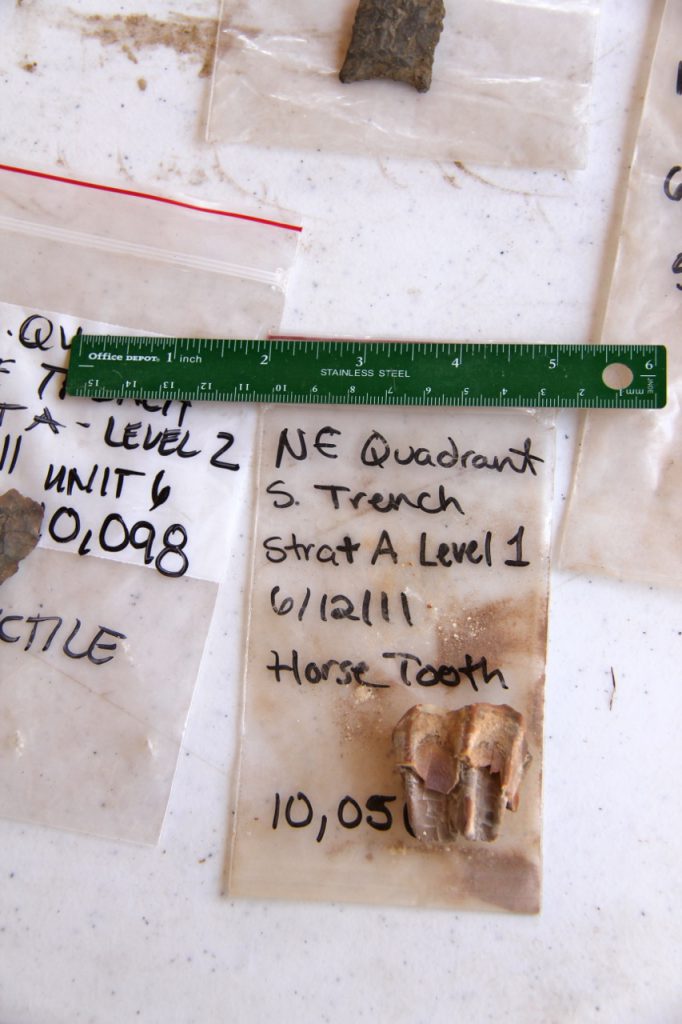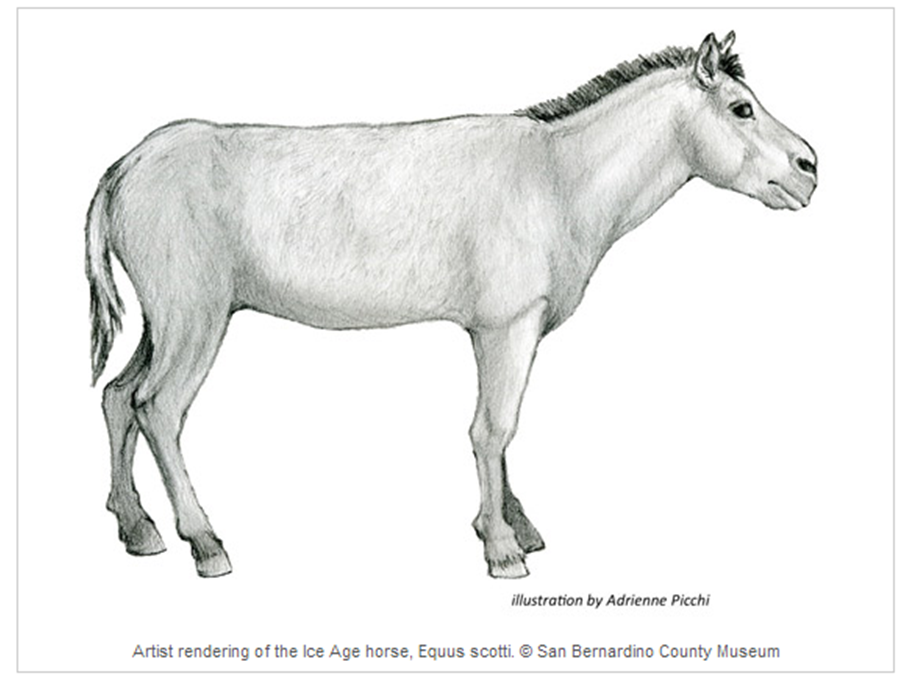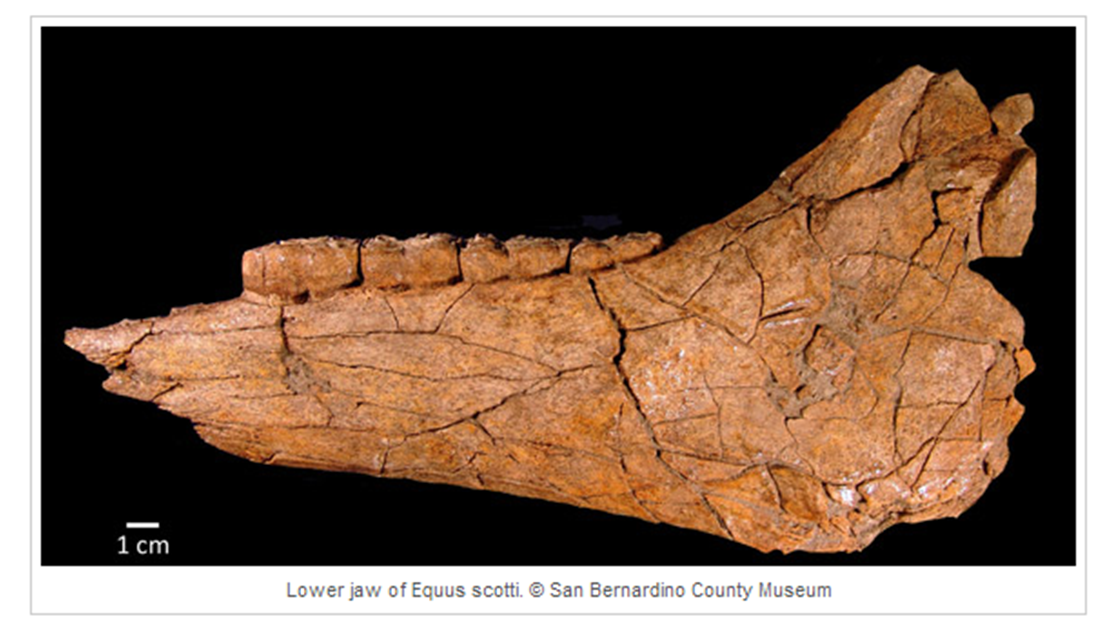Exciting Horse Fossil Discovery in Nevada Desert

Horses, burros and their ancestors have been in our deserts for millions of years.
A short video on wild burros at Circle Ranch appears below this article.
Scientists excavating an Ice Age mammoth skeleton from the Tule Springs area north of Las Vegas, Nevada, uncovered the remains of a second animal that is causing more excitement than the original find: a skull and lower jaw of an extinct horse species.
Horses are not uncommon in the Tule Springs fossil record, but this one differs from all those discovered there before, according to the San Bernardino County Museum scientists. It has a name.
The new fossils belong to the extinct species Equus scotti, a large horse common in much of western North America during the Pleistocene Epoch – the “Ice Ages”. The species has never before been reported from Tule Springs or Nevada.
“You might say we’ve been through the desert on a horse with no name,” jokes Eric Scott, curator of paleontology for the San Bernardino County Museum in Redlands, California, and a specialist in Ice Age horses. “Until now.”
Local volunteers from Las Vegas were instrumental in the discovery.
“Our research funding from the Bureau of Land Management includes a strong public outreach component,” explains Kathleen Springer, senior curator of geological sciences for the San Bernardino County Museum and lead scientist for the research program in the upper Las Vegas Wash.
“Because of this, we set up Nevada’s first paleontology-based site stewardship program, getting local citizens involved in our research. And now it’s paid off – in a big way!”
Springer discovered the fossil site in 2003, during a survey conducted by scientists from the California museum and funded by the Las Vegas district office of the Bureau of Land Management.
The original find – a tusk and tooth of a mammoth just peeking out at the surface – suggested that multiple parts of the skeleton might be present.
In 2012, Springer’s mammoth site was selected for excavation as part of the bureau’s celebration of 50 years of science at Tule Springs.
The presence of multiple bones at the site made it ideal for excavation by site stewards working alongside museum paleontologists.
Brushing through desert sediments at the surface quickly revealed fragments of horse teeth mixed in with the mammoth fossils.
Careful digging teased out more horse teeth, then both sides of the lower jaw, and finally the skull.
The new finds preserve anatomical features never before seen in any horses from Tule Springs, making firm identifications possible for the first time.
The site has been dated to nearly 12,000 years in age, making the fossils among the youngest records of Equus scotti anywhere in North America. And the new discovery is forcing scientists to revise their understanding of horse evolution and extinction at the end of the Ice Ages.
Scott notes that horse fossils are fairly abundant from Tule Springs and the upper Las Vegas Wash. His studies have revealed that three species of horse lived in this area during the Pleistocene Epoch. But all of the earlier remains discovered there, both during earlier expeditions and currently during the past decade of work by the San Bernardino County Museum, weren’t sufficiently complete to make firm species identifications possible.
“There have been some species names suggested here and there, but nothing really concrete,” observes Scott. “It’s a long-running joke with our team in Vegas that every time a new site is excavated, I plead for them to find a horse I can name!”
With identifiable horse fossils so scarce, paleontologists have long been forced to make inferences about what horse species were present in and around Tule Springs. And since the world-famous Rancho La Brea “tar pits” in southern California are relatively close by, other scientists have proposed that the large horse from that site was also present elsewhere throughout the Mojave Desert and the southwest.
“We now think that’s erroneous,” says Scott. “Our new horse from Vegas has a different anatomy from the big La Brea horse. It looks more like large Ice Age horses from northern Nevada that were living at about the same time.”
The difference is critical. Equus scotti was a highly successful species throughout much of western North America for most of the Ice Ages, including southern California and Nevada.
The new discovery shows that these horses survived in southern Nevada right up until the end of the Pleistocene – a fact not before known. But in southern California, the species was replaced in the later Ice Ages by an anatomically distinct form.
“That’s likely either a pulse of evolution – a speciation event – or else the immigration of a different species northwards into California from Mexico,” says Scott. “Either way, we can now clarify the timing and geographic extent of this episode, and the relationships of these two species, in a very exciting way. And it means we had as many as four horse species living in the American southwest at the end of the Ice Ages. Compared to horses today, that’s quite a lot of species!”
Notes Springer: “With the upper Las Vegas Wash under consideration as a possible national monument, this find really emphasizes that even after decades of work there’s still a lot for us to learn about the Ice Ages at Tule Springs.”
The fossils are currently under study at the San Bernardino County Museum.
NOTE: Story originally published by by Horsetalk.co.nz on Jun 05, 2013

This ancient wild horse tooth was found in the Sierra Diablo Cave, on Circle Ranch.
The wild burros at Circle Ranch resemble and descend from animals that lived in our deserts for millions of years.
Circle Ranch Burros from Christopher Gill on Vimeo.



